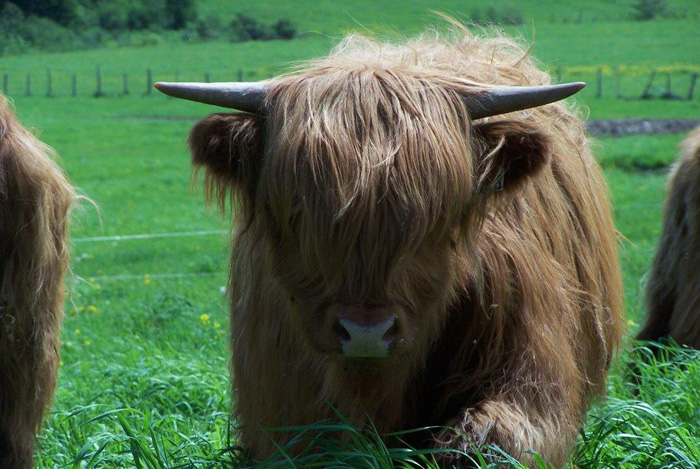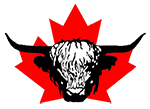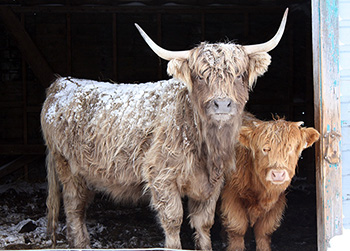Mature Weight
Much like the Highland cattle in ancient Scotland, Canadian Highlands are raised in vastly different environmental conditions. The wide range seen in the size of cattle within the breed is due mainly to this effect. The following average weights are for cattle that have not had their growth affected by severe climate or restricted diet:
- Mature bulls weigh 1,800 pounds (800 kilograms) in breeding condition.
- Mature cows weigh 1,100 pounds (500 kilograms) in breeding condition.
- Steers will finish at about 1,000 pounds (450 kilograms). This weight can be attained with heavy feeding as a long yearling but most breeders prefer to grow their steers on pasture and finish them at two years.
Hair
Highlands have a double coat of hair - a downy undercoat and a long outer coat which may reach 13 inches, and which is well-oiled to shed rain and snow. With the double coat of hair and thick hide, the Highland has been adapted by nature to withstand great exposure. It is not uncommon for Highlands to shed this heavy hair coat when exposed to a hot dry climate and then grow a new one as the damp cold weather returns.
Rustic Nature
Hardiness
We have known for a long time that Highland cattle have a high level of resistance and a surprising ability to survive, sometimes in very difficult conditions.
Highlands have the ability to adapt to a more hostile environment, grazing in poor or abandoned pastures. This strength is definitely an advantage for farmers wishing to produce beef under more arduous conditions using natural inputs.
However, to maximize the performance of their livestock, encourage maximum development and maintain good health farmers will benefit by providing the animals with a healthy diet that ensures an adequate supply of minerals * and nutrients and to provide a comfortable environment.
The Highland's proven ability to produce top quality meat without the addition of expensive high quality feed makes this breed the perfect choice for farmers who wish to produce beef on a forage diet. To do this successfully an adequate ration must be provided to allow for a growth rate of approximately 2 lb/day right up to slaughter. Rotational grazing is one method which has been shown to achieve these results.
* For example, in Canada, many regions are known for their low rate or even near absence of selenium in the soil. It is important to overcome this deficiency which often causes irreparable effects on calves and adult animals.
Maternal Instinct
Mothering instinct is highly developed in the Highland cow. Abandoned calves, even for first-calf heifers, are rare. This strong protective inclination of the cow minimizes predator losses that can even extend to sheep that are pastured in the same field. The Highland calf is exceptionally hardy and grows rapidly up to weaning.
The Highland cow has a long productive life and many herds average 12 calves from each cow. This greatly reduces their replacement cost, a most important factor these days.





